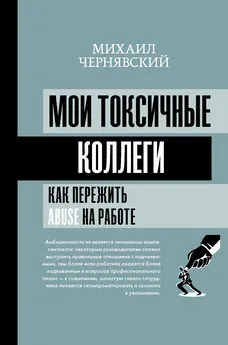Роберт Хаэр - Змеи в костюмах [Как вовремя распознать токсичных коллег и не пострадать от их деструктивных действий]
- Название:Змеи в костюмах [Как вовремя распознать токсичных коллег и не пострадать от их деструктивных действий]
- Автор:
- Жанр:
- Издательство:Литагент МИФ без подписки
- Год:2021
- Город:Москва
- ISBN:9785001179658
- Рейтинг:
- Избранное:Добавить в избранное
-
Отзывы:
-
Ваша оценка:
Роберт Хаэр - Змеи в костюмах [Как вовремя распознать токсичных коллег и не пострадать от их деструктивных действий] краткое содержание
Все чаще именно впечатление лидера команды и других участников оказывается важнее реальных показателей. Это создает благоприятную среду для процветания офисных хищников, которые обладают своеобразным шармом и навыками манипуляций. Они способны принимать сложные решения, прекрасно контролируют эмоции и не теряются в трудных ситуациях. Поначалу коллеги даже не замечают их деструктивного поведения. А зря.
Эта книга поможет вам вовремя распознать токсичного коллегу, подчиненного, руководителя и не пострадать от его действий. Вы научитесь не только идентифицировать психопатов по их характерным чертам, стратегиям поведения, методам управления жертвами и мотивации, но и найдете свой способ защиты. Для кого эта книга
Для тех, кто хочет сформировать цивилизованные и продуктивные рабочие отношения в своей компании.
Для тех, кто хочет научиться распознавать офисных змей или по долгу службы должен их отлавливать.
Для всех, кто работает в корпоративных структурах.
На русском языке публикуется впервые.
Змеи в костюмах [Как вовремя распознать токсичных коллег и не пострадать от их деструктивных действий] - читать онлайн бесплатно ознакомительный отрывок
Интервал:
Закладка:
92
https://www.quora.com/What-is-the-meaning-of-the-Chaos-is-a-ladder-quote-from-Game-of-Thrones.
93
Michael Deacon, April 7, 2019.
94
Halpin, A. W., & Winer, B. J. (1957). A factorial study of the leader behavior descriptions. In R. M. Stogdill & A. E. Coons (Eds.), Leader behavior: Its description and measurement. Columbus, OH: Bureau of Business Research, Ohio State University.
95
Babiak, P., Neumann, C. S., & Hare, R. D. (2010). Corporate psychopathy: Talking the walk. Behavioral Sciences and the Law, 28, 174–193. doi: 10.1002/bsl.925. Статья доступна по адресу: https://www.sakkyndig.com/psykologi/artvit/babiak2010.pdf.
96
Mokros, A., Hare, R. D., Neumann, C. S., Santtila, P., Habermeyer, E., & Nitschke, J. (2015). Variants of psychopathy in adult male offenders: A latent profile analysis. Journal of Abnormal Psychology, 124, 372–386. doi: 10.1037/abn0000042.
97
Некоторые фрагменты этой главы в измененном виде взяты из книги Babiak, Neumann, & Hare (2010), Mokros and colleagues (2015), и последних аналитических работ Крейга Ньюмана.
98
Lowman, R. L. (1989). Pre-employment screening for psychopathology: A guide to professional practice. Sarasota, FL: Professional Resource Series. Professional Resource Exchange, Inc.
99
Hare, R. D., & Neumann, C. S. (2008). Psychopathy as a clinical and empirical construct. Annual Review of Clinical Psychology, 4, 217–246. doi: 10.1146/annurev.clinpsy.3.022806.091452.
100
Схема Понци, или финансовая пирамида, – мошенническая инвестиционная афера, выплачивающая старшим инвесторам деньги, собранные от новых инвесторов; названа по имени мошенника Чарльза Понци, весьма удачно пользовавшегося ею. Прим. ред.
101
Hare, R. D. (2003). Manual for the Revised Psychopathy Checklist (2nd ed.) Toronto, ON: Multi-Health Systems.
102
Babiak, P., Neumann, C. S., & Hare, R. D. (2010). Corporate psychopathy: Talking the walk. Behavioral Sciences and the Law, 28, 174–193, p.183. doi: 10.1002/bsl.925. Статья доступна по адресу: https://www.sakkyndig.com/psykologi/artvit/babiak2010.pdfBabiak, P., Neumann, C. S., & Hare, R. D. (2010). Corporate psychopathy: Talking the walk. Behavioral Sciences and the Law, 28, 174–193, p.185.
103
Neumann, C. C., & Hare, R. D. (2008). Psychopathic traits in a large community sample: Links to violence, alcohol use, and intelligence. Journal of Consulting and Clinical Psychology, 76, 893–899. doi: 10.1037/0022-006X.76.5.893. Информация получена из исследования оценки риска насилия среди пациентов в MacArthur Study Group. См. (Hare, R. D., Black, P., & Walsh, Z. (2013). The PCL-R: Forensic applications and limitations. In R. P. Archer & E. M. A. Wheeler (Eds.), Forensic uses of clinical assessment instruments (2nd ed., pp. 230–265). New York, NY: Routledge).
104
Coid, J., Yang, M., Ullrich, S., Roberts, A., & Hare, R. D. (2009). Prevalence and correlates of psychopathic traits in the household population of Great Britain. International Journal of Law and Psychiatry, 32, 65–73. doi: 10.1016/j.ijlp.2009.01.002.
105
Babiak, P., Neumann, C. S., & Hare, R. D. (2010). Corporate psychopathy: Talking the walk. Behavioral Sciences and the Law, 28, 174–193. doi: 10.1002/bsl.925. Download the article from www.hare.org.
106
Babiak, P., Neumann, C. S., & Hare, R. D. (2010). Corporate psychopathy: Talking the walk. Behavioral Sciences and the Law, 28, 174–193. doi: 10.1002/bsl.925. Download the article from www.hare.org, p. 190–191.
107
PriceWaterhouseCoopers. (2018). Pulling fraud out of the shadows: Global Economic Crime and Fraud Survey, 2018. www.pwc.com/fraudsurvey.
108
PriceWaterhouseCoopers. (2018). Pulling fraud out of the shadows: Global Economic Crime and Fraud Survey, 2018. www.pwc.com/fraudsurvey, р. 9.
109
Boddy, C. R. (2014). Corporate psychopaths, conflict, employee affective well-being and counterproductive work behavior. Journal of Business Ethics, 121, 107–121. doi: 10.1007/s10551-013-1688-0.
110
Boddy, C. R., Ladyshewsky, R. K., & Galvin, P. (2010). Leaders without ethics in global business: Corporate psychopaths. Journal of Public Affairs, 10, 121–138. doi: 10.1002/pa.352.
111
Boddy, C. R., Ladyshewsky, R. K., & Galvin, P. (2010). Leaders without ethics in global business: Corporate psychopaths. Journal of Public Affairs, 10, 121–138. doi: 10.1002/pa.352, р. 134.
112
Deutschman, A. (2005). Is your boss a psychopath? Fast Company Magazine, July, 2005. Retrieved from https://www.fastcompany.com/53247/your-boss-psychopath
113
Deutschman, A. (2005). Is your boss a psychopath? Fast Company Magazine, July, 2005. Retrieved from https://www.fastcompany.com/53247/your-boss-psychopath, р. 48.
114
Из личного общения с Робертом Хаэром, предоставлено Клаудией Рой из Multi-Health Systems 7 октября 2010 года.
115
Jones, D. N., & Figueredo, A. J. (2013). The core of darkness: Uncovering the heart of the Dark Triad. European Journal of Personality, 27, 521–531. doi: 10.1002/per.1893.
116
Jones, D. N., & Hare, R. D. (2016). The mismeasure of psychopathy: A commentary on Boddy’s PMMRV. Journal of Business Ethics, 138, 579–588. doi: 10.1007/s10551-015-2584-6.
117
Jones, D. N., & Hare, R. D. (2016). The mismeasure of psychopathy: A commentary on Boddy’s PMMRV. Journal of Business Ethics, 138, 579–588. doi: 10.1007/s10551-015-2584-6, р 585.
118
Babiak, P., Neumann, C. S., & Hare, R. D. (2010). Corporate psychopathy: Talking the walk. Behavioral Sciences and the Law, 28, 174–193. doi: 10.1002/bsl.925. Статья доступна по адресу: https://www.sakkyndig.com/psykologi/artvit/babiak2010.pdf.
119
https://www.cfainstitute.org/en/research/cfa-magazine/2012/the-financial-psychopath-next-door.
120
https://www.cfainstitute.org/en/research/cfa-magazine/2012/the-financial-psychopath-next-door, р. 34.
121
Из личной переписки между Дж. Грохолем и Р. Хаэром от 3 мая 2012 года.
122
http://psychcentral.com/blog/archives/2012/03/06/untrue-1-out-of-every-10-wall-street-employees-is-a-psychopath/.
123
M. Steinberger, New York Times Magazine, December 12, 2004; https://www.nytimes.com/2004/12/12/magazine/psychopathic-ceos.html.
124
Kelsey, K. R., Rogers, R., & Robinson, E. V. (2015). Self-report measures of psychopathy: What is their role in forensic assessments? Journal of Psychopathology and Behavioral Assessment, 37, 380–391. doi: 10.1007/s10862-014-9475-5.
125
Sellbom, M., Lilienfeld, S. O., Fowler, K. A., & McCrary, K. L. (2018). The self-report assessment of psychopathy: Challenges, pitfalls, and promises. In C. J. Patrick (Ed.), Handbook of psychopathy (2nd ed., pp. 211–258). New York, NY: Guilford Press.
126
Babiak, P. (1995). When psychopaths go to work: A case study of an industrial psychopath. Applied Psychology: An International Review, 44, 171–188. doi: 10.1111/j.1464–0597.1995.tb01073.x.
127
Mathieu, C., Hare, R. D., Jones, D. N., Babiak, P., & Neumann, C. S. (2013). Factor structure of the B-Scan 360: A measure of corporate psychopathy. Psychological Assessment, 25, 288–293. doi: 10.1037/a0029262.
128
Paulhus, D. L., Neumann, C. S., & Hare, R. D. (2016). Self-Report Psychopathy Scale 4th Edition (SRP-4). Toronto, ON: Multi-Health Systems.
129
Mathieu, C., & Babiak, P. (2016b). Validating the B-Scan Self: A self-report measure of psychopathy in the workplace. International Journal of Selection and Assessment, 24, 272–284. doi: 10.1111/ijsa.12146.
130
LeBreton, J. M., Shiverdecker, L. K., & Grimaldi, E. M. (2018). The dark triad and workplace behavior. Annual Review of Organizational Psychology and Organizational Behavior, 5, 387–414. doi: 10.1146/annurev-orgpsych-032117-104451.
131
Coid, J., Yang, M., Ullrich, S., Roberts, A., & Hare, R. D. (2009). Prevalence and correlates of psychopathic traits in the household population of Great Britain. International Journal of Law and Psychiatry, 32, 65–73. doi: 10.1016/j.ijlp.2009.01.002.
132
Lynam, D. R., Gaughan, E. T., Miller, J. D., Mullins-Sweatt, S., & Widiger, T. A. (2010). Assessing basic traits associated with psychopathy: Development and validation of the Elemental Psychopathy Assessment. Psychological Assessment, 23, 108–124. doi: 10.1037/a0021146.
133
Neumann, C. C., & Hare, R. D. (2008). Psychopathic traits in a large community sample: Links to violence, alcohol use, and intelligence. Journal of Consulting and Clinical Psychology, 76, 893–899. doi: 10.1037/0022-006X.76.5.893.
134
Verona, E., & Vitale, J. (2018). Psychopathy in women. In C. J. Patrick (Ed.), Handbook of psychopathy (2nd ed., pp. 509–528). New York, NY: Guilford Press.
135
Mathieu, C., & Babiak, P. (2016b). Validating the B-Scan Self: A self-report measure of psychopathy in the workplace. International Journal of Selection and Assessment, 24, 272–284. doi: 10.1111/ijsa.12146.
136
Mathieu, C., Babiak, P., & Hare, R. D. (2019). Use of the B-Scan in a large sample of public employees. Работа над рукописью еще не окончена.
137
Raver, J. L., & Nishii, L. H. (2010). Once, twice, or three times as harmful? Ethnic harassment, gender harassment, and generalized workplace harassment. Journal of Applied Psychology, 95, 236. doi: 10.1037/a0018377.
138
Andersson, L. M., & Pearson, C. M. (1999). Tit for tat? The spiraling effect of incivility in the workplace. Academy of Management Review, 24, 452–471. doi: 10.5465/AMR.1999.2202131.
139
Skarlicki, D. P., Folger, R., & Tesluk, P. (1999). Personality as a moderator in the relationship between fairness and retaliation. Academy of Management Journal, 42, 100–108. doi: 10.2307/25687. https://www.jstor.org/stable/256877.
140
Douglas, S. C., & Martinko, M. J. (2001). Exploring the role of individual differences in the prediction of workplace aggression. Journal of Applied Psychology, 86, 547–559. doi: 10.1037//0021-9010.86.4.547.
Читать дальшеИнтервал:
Закладка:
![Обложка книги Роберт Хаэр - Змеи в костюмах [Как вовремя распознать токсичных коллег и не пострадать от их деструктивных действий]](/books/1056557/robert-haer-zmei-v-kostyumah-kak-vovremya-raspoznat.webp)



![Патрисия Эванс - Не бьет, просто обижает [Как распознать абьюзера, остановить вербальную агрессию и выбраться из токсичных отношений] [litres]](/books/1065780/patrisiya-evans-ne-bet-prosto-obizhaet-kak-raspoz.webp)





